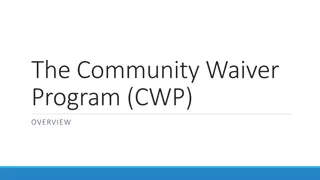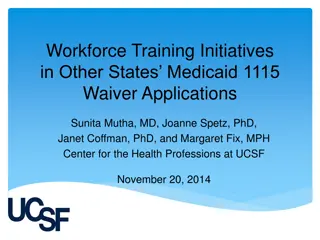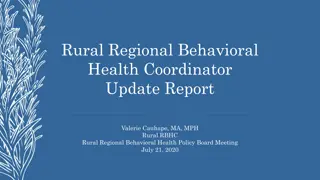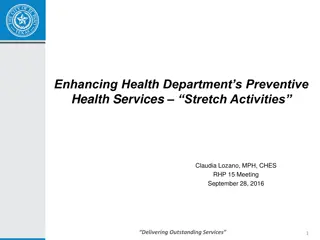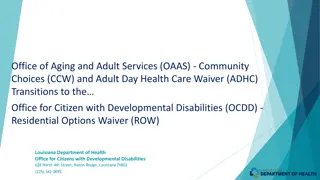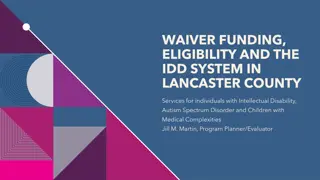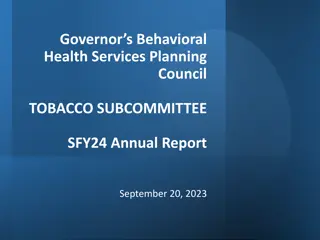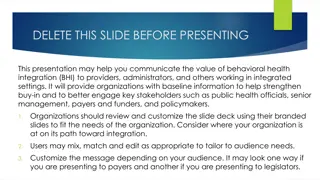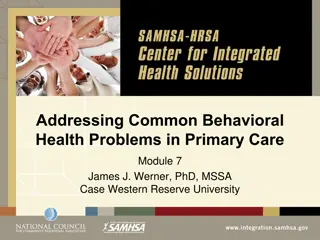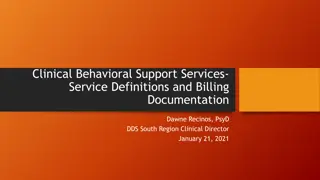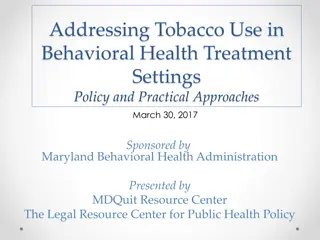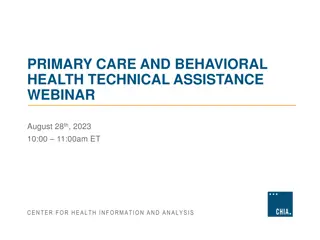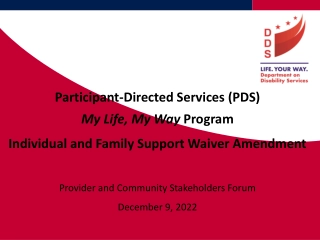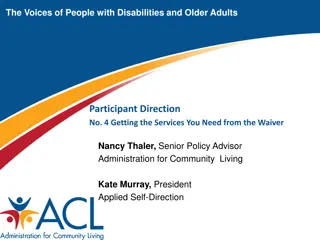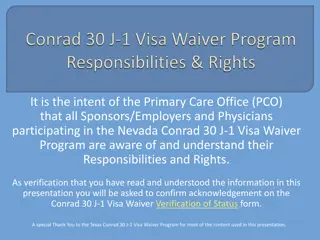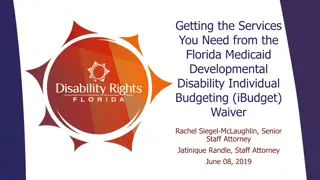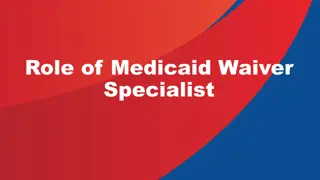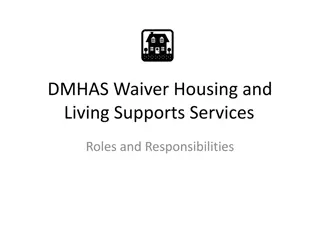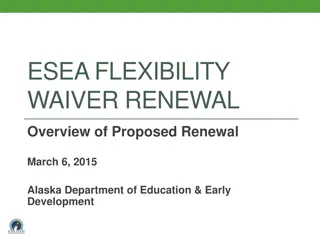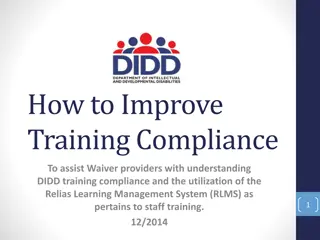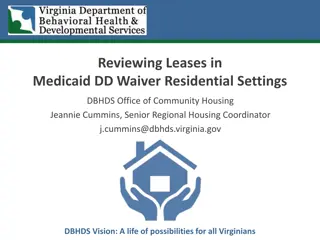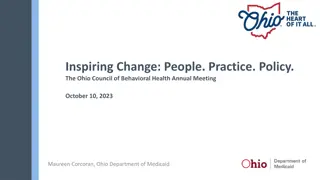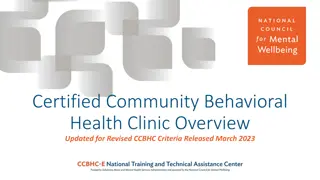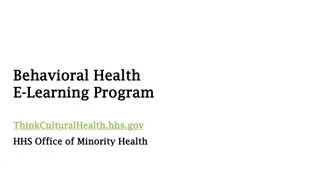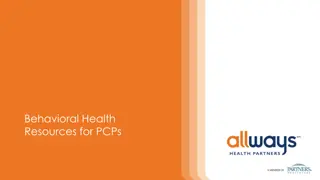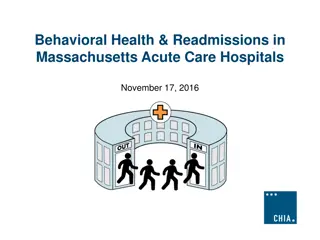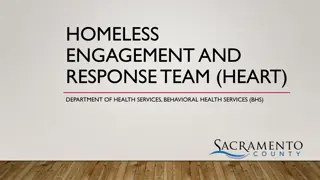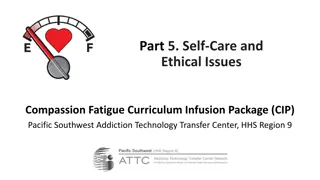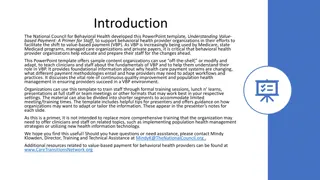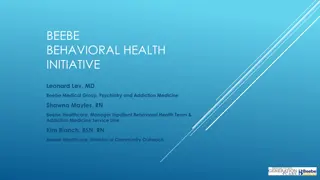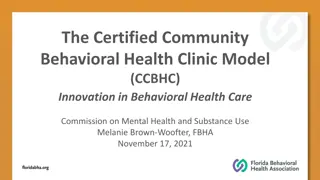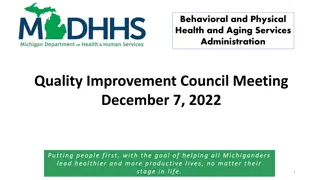Behavioral Health 1115 Waiver Implementation Plan
This document outlines the challenges in accessing substance use disorder (SUD) treatment, including the lack of knowledge around levels of care and high utilization of services in acute settings leading to deaths. The implementation plan focuses on improving access to critical levels of care, implementing evidence-based standards, and enhancing care coordination to address opioid abuse and SUD effectively. Strategies include screening all Medicaid recipients, implementing ASAM Criteria, and expanding treatment options for youth and adults.
Download Presentation

Please find below an Image/Link to download the presentation.
The content on the website is provided AS IS for your information and personal use only. It may not be sold, licensed, or shared on other websites without obtaining consent from the author. Download presentation by click this link. If you encounter any issues during the download, it is possible that the publisher has removed the file from their server.
E N D
Presentation Transcript
Division of Behavioral Health 1115 SUD and Behavioral Health Waivered Services Kathryn Chapman, LCSW, MAC State Opioid Treatment Authority Jim McLaughlin, LPC Mental Health Clinician III
1115 Waiver: SUD Implementation Highlights
Why? Death Can t access treatment easily Average time to get into treatment: 1 week to three months for residential Accessing services is complicated with multiple steps that are difficult to navigate when an individual is in crisis. Lack of knowledge around levels of care Individuals seeking treatment are not informed about levels of care Agency bias to refer to their own program/level of care Not all SUD staff are proficient at using the ASAM High utilization of services in acute settings Lack of access to treatment after withdrawal management services are provided Lack of withdrawal management services Not all withdrawal management programs provide withdrawal management for all drugs. 73 deaths during the period of 9/1/2018 8/31/2019
SUD Implementation Plan: Milestones 1. 2. Access to critical levels of care for OUD and other SUDS Widespread use of evidence-based, SUD specific patient placement criteria Use of nationally recognized, evidenced based SUD program standards to set residential treatment provider qualifications Sufficient provider capacity at each level of care Implementation of comprehensive treatment and prevention strategies to address opioid abuse and OUD and; Improved care coordination and transitions between levels of care 3. 4. 5. 6.
How will we do this? 1. Screen all Medicaid recipients, regardless of setting, using industry recognized, evidenced based SUD screening instruments to identify symptoms and to intervene early. SBIRT in 10 emergency departments (statewide) 2. Implement ASAM Criteria (3rd edition) to match individuals to appropriate services and tools necessary for recovery Using ASAM to define services across the system Open Beds to provide linkages to services
continuedhere is how we will achieve these goals 3. Increase SUD treatment options for youth (ages 12-17) and adult (over 18) Medicaid recipients More emphasis on step up step down options such as intensive outpatient (IOP) and partial hospitalization (PHP) IMD requirement lifted- increasing residential capacity Expand access to pharmacotherapy SUD Care Coordination * NEW SERVICE Recovery Support Services * NEW SERVICE ASAM Level 3.3 * NEW SERVICE
continued 4. Standards for certification Provisional Designations 5. Elevate SUD workforce Qualified addiction professionals
What can you do? Provide the new services-IOP, CRSS, SUD Care Coordination, etc. Consider adding new levels of care Integrate pharmacotherapy into your services Get your staff trained and (provide ongoing training in ASAM and EBPs) Support your workforce- encourage professional development for SUD counselors to obtain certification
Workforce Development Efforts MAT Guide posted on DBH website Withdrawal Management information posted on DBH website State sponsored ASAM trainings State/ORN sponsored trainings on MAT for Therapeutic Drug Court Annual MAT Conference
1115 Waiver: Behavioral Health A more comprehensive behavioral health system of care - filling the gaps in our system. Our system has been heavily focused on either clinic based interventions or hospital care missing many of the types of services in between. Many of the needs of our clients are unmet because of this.
1115 Waiver: Behavioral Health Our goal with the 1115 is to address these gaps With emphasis on early interventions, community- based outpatient services, residential treatment when appropriate. A significant proportion of Alaska s children and adolescents encounter the child welfare system or juvenile justice system at some point in their lives. But too often cared for in residential, Psychiatric Regional Treatment Facilities (PRTFs), or inpatient hospital services.
1115 Waiver: Behavioral Health For children already receiving residential services, there are very few step-down services to assist when they re discharged. There is no State Plan residential treatment service in Alaska for adults with serious mental health needs. Often assisted living homes have been left to provide housing for these individuals.
1115 Waiver: Behavioral Health Individuals whose needs that exceed the capabilities of these homes and find themselves instead homeless or incarcerated. There is limited availability of crisis intervention/stabilization services designed to identify and intervene before costlier acute services are necessary. Law enforcement - police departments, troopers, and VPSOs are the de facto crisis intervention providers for our communities.
The 1115 Behavioral Health Services Assessment and treatment plan services. Evidence-based assessments Reassessments at regular intervals to determine the necessary intensity of service and level of care. Treatment planning will be reimbursed.
Home Based Family Treatment Services Home-based family treatment services. (Child/Adolescent) Treatment and wrap-around services in the child/adolescent s home. Intensive case management usually with multiple contacts per week. For children/youth at moderate and high risk of out-of-home placement including those discharging from residential or psychiatric hospital or juvenile detention. Teaching and assisting parents with communication, problem solving and conflict resolution skill building Helping children/youth with self-regulation, anger management, and managing moods. Coordination with schools and community-based services.
Therapeutic Treatment Home Services Therapeutic treatment home services. (Child/Adolescent) Specially-trained therapeutic treatment homes for children or adolescents who cannot be stabilized in a less intensive home settings. Small home settings with a licensed foster care parent. Homes provides daily activities, skills development, crisis intervention and support services, medication monitoring, and a variety of other supports. Close supervision of homes by clinical staff. Parents, kinship caregivers and foster care parents provided with specialized training and consultation in mental illness, trauma, and training specific to the needs of each child.
Community Based Case Management Intensive Case Management services (child, adolescent and adult) Assertive Outreach services engagement outside of the clinic often in the home but including street outreach, work, and other community settings. For children/adolescents at risk of out-of-home placement, ICM includes community-based wraparound intensive case management service. For adults, ICM is a comprehensive case management service for individuals with acute mental health needs who require on-going and long-term support but have fewer intensive support needs than individuals receiving ACT services Small staff recipient ratios
Community Based Case Management Assertive Community Treatment (ACT) (adult) ACT is a specialized in-community, outreach program for young adults and adults with the most serious mental health issues (i.e. highly vulnerable adults, frequently incarcerated, hospitalized). It s an evidence-based practice developed and refined over the last 35 years with very specific service standards. The staff-to-recipient ratio will be small (even smaller than Intensive Case Management ) Services must be primarily provided in the community. There is an expectation of multiple staff contacts per week with sometimes multiple contacts per day. Services are available 24-hours a day, seven days a week, according to recipient need;
Community Based Case Management Community recovery support services (Child, adolescent, adult) Individual and group services delivered by professionals and para- professionals in the community and in clinics. Recovery coaching- direct services that provide guidance, support and encouragement from the expertise of the trained recovery professional. Daily living skill building Facilitation of level of care transitions (i.e. post hospitalization) Peer-to-peer services, mentoring, & coaching Beneficiary & Family Education/Training/Support- Psychoeducational services Relapse prevention Child therapeutic support services
Structured Treatment Services Intensive outpatient services (Child, adolescent, adult) Intensive outpatient clinic-based services which include structured weekly programming provided to individuals when determined to be medically necessary. Identified minimum and maximum proscribed levels of weekly service. Individual, group, and psychiatric services. The MH equivalent of IOP which has been a mainstay of SUD treatment.
Structured Treatment Services Partial hospitalization program services (Child, adolescent, adult) Structured treatment services designed to prevent relapse or the need for higher level of hospitalized care Maintains daily scheduled treatment activities by providers qualified to treat individuals with significant mental health and co-occurring disorders; Direct access to psychiatric and medical consultation and treatment, including medication services; Level of structured treatment service over and above the weekly maximum for Intensive Outpatient Services.
Adult Behavioral Health Residential Adult behavioral health residential treatment services A therapeutically-structured, supervised environment for adults with acute mental health needs whose health is at risk while living in other settings in the community. Needing a higher level of care than that required for other adult residents in assisted living home care. Provided by an interdisciplinary treatment team Specified minimum levels of clinical and treatment services Must be supported by a lead case worker and lead clinician.
Crisis Response Services Peer-based crisis services (Adolescent, adult) Services delivered by credentialed peer support workers to help an individual avoid the need for hospital emergency department services or the need for psychiatric hospitalization. Facilitation of transition to other community based resources or natural supports; and Delivered in a community setting with medical support and are coordinated within the context of an individualized person-centered plan
Crisis Response Services Mobile Outreach and Crisis Response Services (Child, adolescent, adult) Trained professionals meet face-to-face with individual in crisis wherever the crisis occurs and in any location where the provider and the individual can maintain safety. Can be provided in coordination with law enforcement Requires rapid face-to-face response To assess and de-escalate the situation, stabilize an individual, connect to the appropriate services or potentially resolve the crisis Available for follow-up services to stabilize and/or to connect to a continuing treatment provider.
Crisis Response Services 23-hour Crisis Observation and Stabilization services (Child, adolescent, adult) Crisis Observation and Stabilization (COS) includes services for up to 23 hours of care in a secure and protected environment. Provided to an individual presenting with acute symptoms of mental, emotional, or substance-use related distress. The primary objective of COS services is to provide prompt evaluation and/or stabilization of individuals presenting with acute symptoms. Intent is a take all customers approach particularly addressing the needs of law enforcement to quickly drop off individuals for assessment and care. Medically staffed with ability to provide psychiatric medications.
Crisis Response Services Crisis Stabilization Services (Child, adolescent, adult) This is a facility-based alternative to or diversion from inpatient hospitalization, offering psychiatric stabilization services on a short-term basis (multiple days) Provided to an eligible individual presenting with acute mental or emotional disorders otherwise requiring psychiatric stabilization and care Services designed to stabilize and restore the individual to a level of functioning that does not require inpatient hospitalization Psychiatric, nursing and clinical services Referral to the appropriate level of post-discharge treatment and support services.
The only thing I knew how to do was to keep on keeping on. - Bob Dylan


